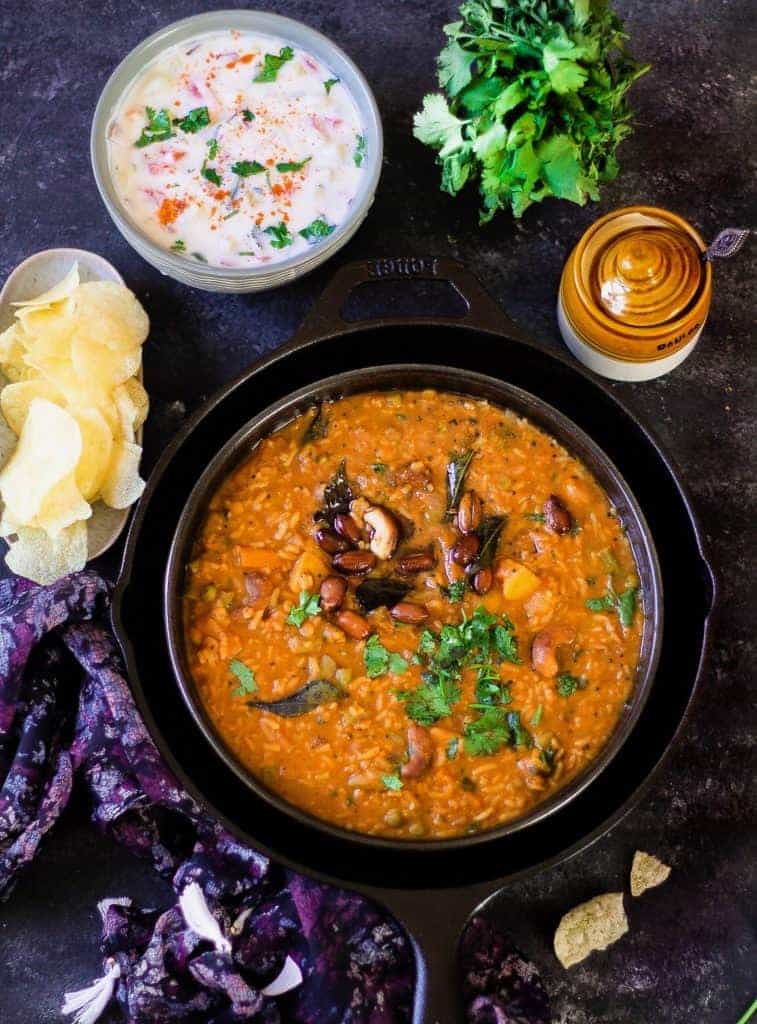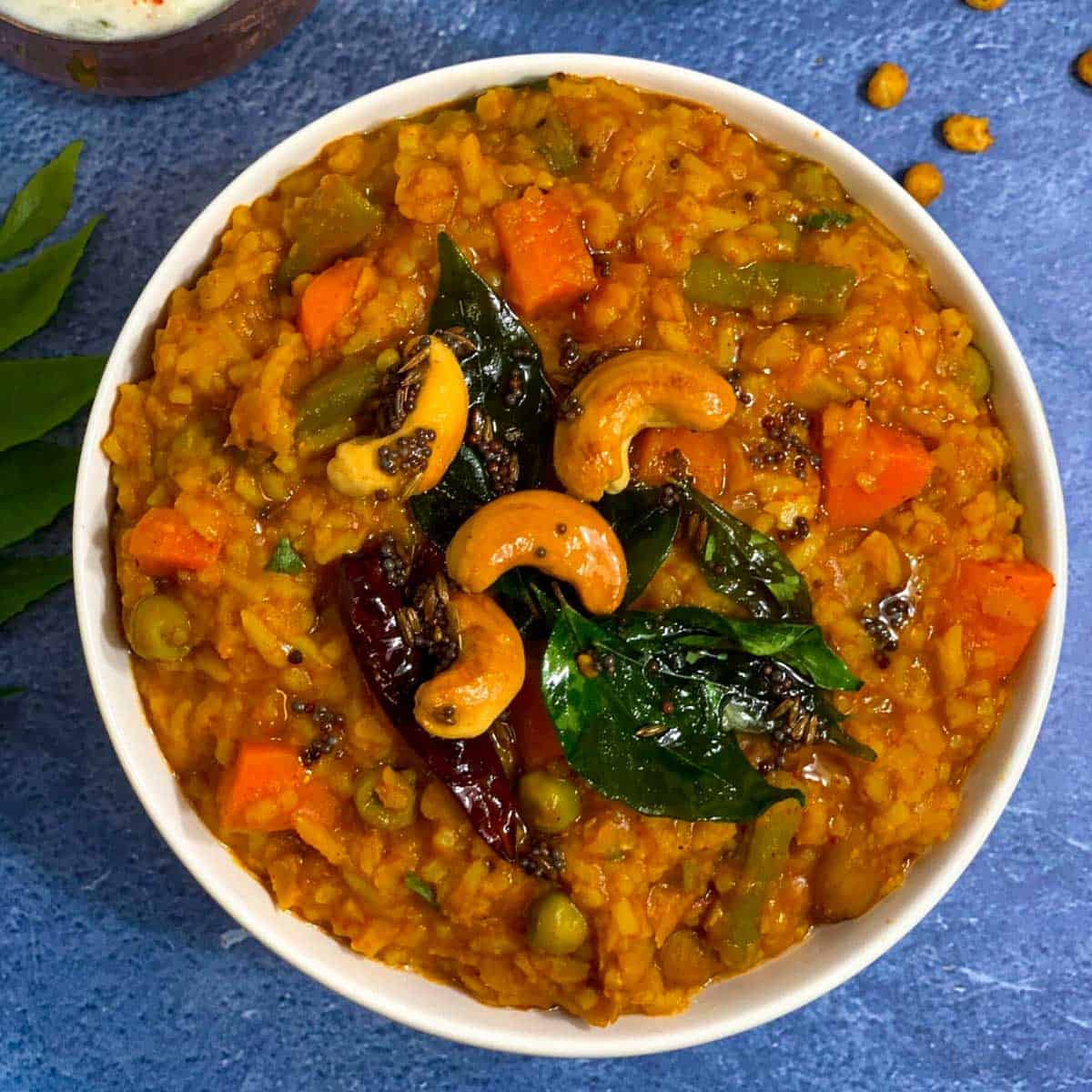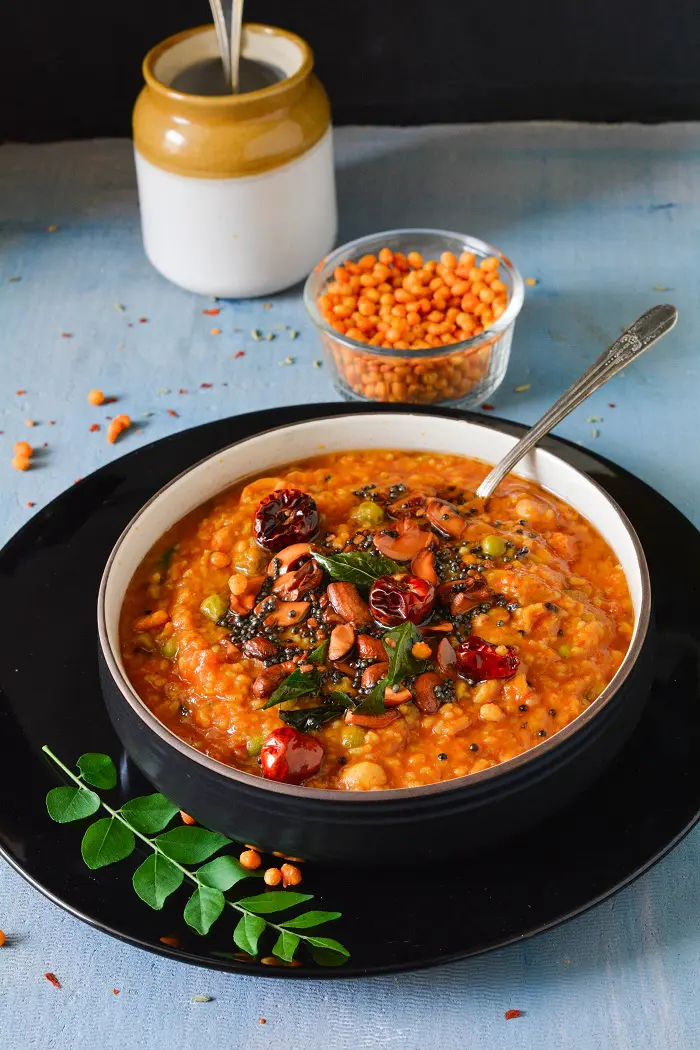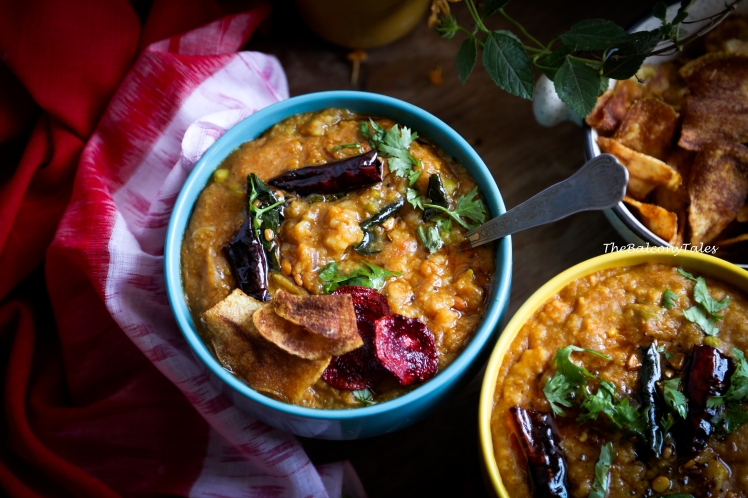Bisi Bele Bath is a rich and comforting rice and lentil dish that hails from the vibrant culinary landscape of Karnataka, a state in India renowned for its array of diverse and flavorful cuisines. Its name literally translates to “hot lentil rice” in Kannada, the local language, and true to its name, it is served hot and is known for its unique taste and satiating qualities.
This traditional dish is a perfect synthesis of carbohydrates from the rice, proteins from the lentils (typically pigeon peas or toor dal), and a plethora of vitamins and minerals from the addition of various vegetables and spices. Bisi Bele Bath is characterized by its distinct flavor that comes from a special spice blend known as Bisi Bele Bath masala, which includes spices like cinnamon, cloves, cardamom, and nutmeg along with dried coconut, chana dal, and urad dal. The spice blend is ground into a fine powder and added to the dish to deliver its signature taste.
Bisi Bele Bath Riceand Lentils Dish Recipe


Bisi Bele Bath Riceand Lentils Dish
Equipment
- 1 large skillet
- 1 electric pressure cooker
Ingredients
FOR THE BISI BELE BATH POWDER
- 4 dried red chiles preferably byadgi chiles
- 3 green cardamom pods
- 3 whole cloves
- 2 curry leaf sprigs
- 11/2 tablespoons coriander seeds
- 11/2 tablespoons Bengal gram
- 1 1-inch cinnamon stick
- 1/2 teaspoon husked whole black lentils
- 1/2 teaspoon cumin seeds
- 1/2 teaspoon peppercorns
- 1/2 teaspoon fenugreek seeds
- 2 kapok buds optional
FOR THE MASALA
- 2 tablespoons ghee
- 1/2 teaspoon mustard seeds
- 1/2 teaspoon fenugreek seeds
- 1/2 teaspoon asafoetida
- 1 curry leaf sprig
- 1/2 cup finely chopped onion
- 2 Roma tomatoes finely chopped
- 21/2 teaspoons salt
- 2 teaspoons powdered jaggery
- 2 teaspoons tamarind paste
- 3 cups chopped mixed vegetables such as bell pepper, eggplant, beans, zucchini, carrot
- 3/4 cup sona masoori rice rinsed, soaked in water for 20 minutes, drained
- 3/4 cup split pigeon peas rinsed, drained, soaked in water for 20 minutes, drained
- 4 cups water
- 2 tablespoons finely chopped fresh cilantro
Instructions
- TO MAKE THE BISI BELE BATH POWDER
- Heat a large skillet over medium heat.
- Add the chiles, cardamom, cloves, curry leaves, coriander seeds, Bengal gram, cinnamon, black lentils, cumin seeds, peppercorns, fenugreek seeds, and kapok buds (if using). Dry- roast the spices for 3 to 4 minutes until the Bengal gram turns light brown. Turn off the heat and let the spices cool.
- Transfer the spices to a spice grinder or clean coffee grinder and grind into a fine powder. Set aside.
- TO MAKE THE MASALA
- In an electric pressure cooker, such as the Instant Pot®, select Sauté and add the ghee to melt. If using a stovetop pressure cooker or pressure pan, heat the pan over medium heat and add the ghee to melt.
- Once melted, add the mustard seeds, fenugreek seeds, asafoetida, and curry leaves. Cook until the mustard seeds begin to sputter, about 1 minute.
- Add the onion and cook for 3 to 4 minutes, or until the onion is soft and translucent.
- Stir in the tomatoes, salt, jaggery, and tamarind paste and cook for 3 minutes, or until the tomatoes become soft and are broken down.
- Add the vegetables and stir in the bisi bele bath powder until thoroughly mixed.
- Add the rice, pigeon peas, and water. Mix well.
- For an electric pressure cooker, lock the lid into place and make sure the valve is in the Sealed position. Select Pressure Cook or Manual and set the time to 20 minutes on High Pressure. Once the cooking is complete, let the pressure release naturally. For a stovetop pressure cooker, place it over medium heat and put the lid on. Ensure the sealing ring is on and place the weight on. Pressure cook until the cooker “whistles” 4 or 5 times. Let the pressure release naturally.
- Carefully unlock and remove the lid. Stir in the cilantro.
Notes
Cooking Tips about Bisi Bele Bath Riceand Lentils Dish

- Quality of Ingredients: The cornerstone of a flavorful Bisi Bele Bath lies in the quality of the masala used. While you can buy the spice mix ready-made, preparing it fresh at home can elevate the taste to another level. Roasting spices such as cinnamon, cloves, cardamom, dried coconut, chana dal, and urad dal before grinding them will bring out their aroma and intensify the flavors.
- Balancing the Rice and Lentil Texture: The rice should be cooked so that it is soft but not mushy, while the lentils (toor dal) should be cooked until they almost disintegrate. The right texture will give your Bisi Bele Bath the perfect consistency once mixed.
- Cooking the Vegetables: Use fresh vegetables for the best nutritional value and taste. Add hard vegetables like carrots and beans early in the cooking process, and softer ones like peas and capsicum later on, to ensure all vegetables are perfectly textured.
- Tamarind Pulp: Tamarind pulp is essential to get the unique tangy flavor of Bisi Bele Bath. Soak tamarind in warm water, then squeeze out the pulp, and strain to remove any seeds or fibers before adding it to the dish.
- Timing of Adding Spice Blend: The Bisi Bele Bath masala should be added to the cooked lentils and rice toward the end of the cooking process. This way, the spices do not lose their potency and aroma.
- Ghee Tempering: A tempering of mustard seeds, curry leaves, dried red chilies, and asafoetida (hing) in ghee is typically poured over Bisi Bele Bath. The hot ghee helps to release and amplify the flavors of the spices and aromatics.
- Consistency Checks: As Bisi Bele Bath cools down, it tends to thicken. Aim for a slightly soupy consistency when finishing cooking because it will continue to absorb liquid and thicken as it sits.
- Garnishes and Accompaniments: Garnish with chopped cilantro and fried cashews or peanuts for a crunchy contrast. Serve with a dollop of ghee on top and crispy papadam or potato chips on the side.
- Resting Time: Let the Bisi Bele Bath sit for 10-15 minutes after cooking. This settling time allows the flavors to meld together beautifully.
- Stir Gently: Stirring too vigorously after adding the masala can break down the rice grains and ruin the texture of your dish. A gentle fold is all that’s needed to combine the ingredients.
Serving suggestions about Bisi Bele Bath Riceand Lentils Dish

- Traditional Condiments: Serve Bisi Bele Bath with a dollop of ghee or clarified butter on top, which adds an irresistible aroma and helps balance out the flavors.
- Crunchy Sides: Add a side of fried cashews or peanuts on top for a crunchy texture contrast. Also, pair it with a crispy papadam or roasted potato chips to complement the soft texture of the dish.
- Raita or Yogurt: Accompany your Bisi Bele Bath with a bowl of cool and creamy raita or plain yogurt, which provides a refreshing counterbalance to the warm spices in the dish.
- Pickle: A little bit of spicy Indian pickle (achar) can enhance the meal with its sharp tanginess and complements the savory profile of Bisi Bele Bath.
- Salads: Serve alongside a simple chopped salad or a Kachumber salad – diced cucumbers, tomatoes, onions with lemon juice, salt, and chili – for a fresh, wholesome meal.
- Toppings: Garnish with fresh coriander leaves and fried onions to add more flavor and texture to the dish.
- Drinks to Pair: A glass of buttermilk spiced with coriander and cumin powder can be a great palate cleanser and also aids in digestion after a hearty Bisi Bele Bath meal.
Top 5 FAQs about Bisi Bele Bath Riceand Lentils Dish

- What does “Bisi Bele Bath” mean? Bisi Bele Bath is a Kannada term, where ‘Bisi’ means hot (temperature), ‘Bele’ means lentils, and ‘Bath’ (pronounced ‘baath’) refers to a rice-based dish. Together, it translates to ‘hot lentil rice dish’ in English.
- How do you make Bisi Bele Bath? Traditionally, Bisi Bele Bath is made by cooking toor dal and rice separately until they are both partially cooked. Vegetables such as carrots, peas, beans, and bell peppers are also prepared and set aside. In the meantime, Bisi Bele Bath masala, a spice blend specific to this dish, is prepared or bought pre-made from stores. The masala typically contains spices like coriander seeds, fenugreek seeds, red chilies, and asafoetida, in addition to dry coconut. Once the rice and dal are partly cooked, they are combined with the masala, tamarind paste, vegetables, and water. The mixture is simmered until the flavors meld and the consistency becomes thick like a porridge. It is often finished with a tempering of mustard seeds, curry leaves, asafoetida, and dried red chilies in ghee.
- What are the key spices in Bisi Bele Bath masala? The key spices that make up Bisi Bele Bath masala typically include dried red chilies, coriander seeds, cinnamon, cardamom, cloves, fenugreek seeds, poppy seeds, and urad dal. Sometimes nutmeg, star anise, and bay leaves can also be added. Dry or desiccated coconut is a common ingredient as well, which adds depth and texture to the masala.
- Can Bisi Bele Bath be made in a pressure cooker? Yes, Bisi Bele Bath can be efficiently prepared in a pressure cooker to save time. Ingredients can be layered or cooked in stages in the pressure cooker, which can drastically reduce cooking time while still infusing the flavors well.
- What is typically served with Bisi Bele Bath? Bisi Bele Bath is typically served hot and is often accompanied by a spoonful of ghee drizzled on top. It can be enjoyed with fried snacks such as papadum, potato chips, or boondi on the side. A simple raita (yogurt salad) or pickle can also accompany the dish as a cool, refreshing condiment.
Bisi Bele Bath is a traditional dish from the state of Karnataka, India. Its name can be translated as “hot lentil rice” in the Kannada language. This hearty meal is known for its rich flavor and the balance of nutrients it provides, owing to its combination of rice, lentils, a variety of vegetables, and a special spice blend known as Bisi Bele Bath masala.

Leave a Reply